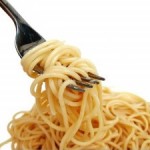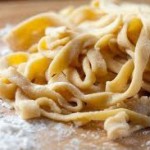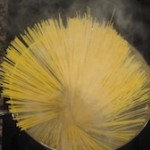The Pasta Cometh
Over the Christmas holidays I received a pasta machine as a gift. It is a simple device. It is manually operated and nothing more than 2 wheels with grooves. It was beautiful, shiny and elegantly sitting on the counter waiting to be explored. The little grooves on the dial of the machine look like little mouths that keep saying “Try me!” They are most certainly waiting for the wonderful dough which will be made into pasta.
Pasta had been around for a long time. Almost every nation has its own version of pasta. When we mention pasta, we only think of Italian, but when we say noodles, and then everybody understands it is the long strand, stringy, dough which can be cooked up with soup, sauce, baked and anything you can imagine.

Dried pasta cooked
Pasta is inexpensive, versatile and most of all it is filling to the stomach. You cannot imagine the warmth that adheres to your stomach when you slurp down a hot mouthful of satisfying pasta on a crispy winter day. Your tongue receive the first caress of this wonderful food that wants so much to slide down your tummy, yet your cheeks want to savour the lingering sensation, and eventually you almost swallow your tongue. A deep sigh at this time is not enough to express satisfaction of all your senses. Eating becomes a rewarding act compared with any other of your achievements.
Pasta can largely be divided into 2 camps, the dry pasta which we find in any super-market and the fresh pasta which we can make it at home. These 2 types of pastas are cooked a bit differently. The dry pasta requires a longer cooking time than the softer homemade pasta.
Here we open up a big topic of proper cooking of pasta. We will try to handle the dry pasta first.

Homemade_pasta
We have a big pot of water, should we add salt to it? Should we add oil to prevent the noodles from sticking? How long should we boil the noodles? Should we use full temperature to cook the pasta? There are enough questions to confuse people. I will try to relate to my own version of cooking the perfect (here is self-claimed and you can disagree) pasta.
Not every stove reacts the same way. You have to know your stove and oven before you call the time. Water is in the pot, the stove is turned to the maximum and you can turn to measure your dry pasta. If you have a lid to the pot, put it on. It takes little time before the water comes to a roaring boil. We are using spaghetti as an example. The normal portion of pasta served in a restaurant is 5 oz. to 6 oz. cooked weight. If your yield from pasta doubles when cooked, then you would need 3 oz. of dry pasta. Since 100 g = 4 oz, it will be safe to reserve 4 oz. of dry pasta per person. A neat way to measure dry pasta will be making a circle with your index finger to the first thumb ring. The dry pasta filling the circle will be about 200 grams.
Put enough water into a large mouth pot.
Put salt into the water and wait for the water to come to a roaring boil. We add salt because we want to season the pasta.
Deposit the dry pasta into the center of the water and let it fall liberally. The pasta should spread out in a circular fashion around the edge of the pot. (This is not mandatory – do not go hay wild because the pasta did not make a circle. The point is to loosen up the pasta so it would not bundle and stick together.)
Push all your pasta immerged in the hot water.
Stir and loosen the pasta right away. At this point, the pasta is till stiff and you might have to wait for it to soften enough before you can stir it freely. Give it a few more stirs and loosen it up more.
The water will eventually come to a boil again. You have to pay attention here. Before the water boils over, decrease the temperature of your stove by turning down the heat to half.
The bubbles will subside and you will give the pasta a stir now and then.
The pasta will eventually soften up and you can fish out a strand after about 8 minutes. Break the strand and feel the texture and inspect the white dot inside the pasta. The white dot is the amount of uncooked pasta. The white dot will eventually develop into a white ring. At this point, turn off the heat and let the residual heat of the hot water finish the pasta for you. Let the pasta sit in the hot water for about 5 minutes. Take the pasta out and you can see the white ring is gone and the center is slightly deeper colour than the outside. It is done. la pasta di dente di el è l’anima di cucinare = el dente pasta is the soul of cooking.
You can adjust the doneness of the pasta to your liking by adjusting the time the pasta sits in the hot water.
Drain or take the pasta out of the water and add them to your desired sauce. Pasta cooked in this way will not stick. It will be el dente, and ready to be enjoyed. Mind you, pasta sitting in water for too long will absorb more liquid and it will expand and becomes mushy. You can also employ the 2-pot technique. Heat the sauce up in one pot while cooking pasta with the other. Then you just use a strainer and take the pasta over and mix in with the sauce.
If you are adventurous enough, you can make a cream sauce, mix the pasta in, put it in a baking dish and spread a layer of cheese on top and bake it in the oven. It will be a totally different dish.

pasta spread out
- baked penne with cheese and cream sauce
Fresh pasta will be different and I am experimenting with my machine to come up with a nice formula. The type of flour we use is important. We desire the winter Durham wheat which is strong flour different from the ordinary cake flour or pastry flour. The winter wheat flour is also called semolina which you can find from local bulk barn or grocery stores. The semolina has the harder quality which gives more tolerance when you are knitting the dough. It has a tendency not to stick together too much.
For the meantime, we stay with the rule, “The simpler, the better”
Cooking, like anything else, starts with a simple principle and you add your favourite twists and turns to it and make it your own version. That is when creativity plays its part. Nowadays things are even simpler since there are so many sauces and spices readymade to be utilized.
Experimentation is the father of invention.
The ultimate goal is to create something (of course it has to be eatable) that looks good, smells good and tastes good.
There is no 1 fixed rule for anything, and that make us all food revolutionaries.